On his whistle-stop visit to the UK, US president Donald Trump is due to meet the Queen, the prime minister and US ambassador Woody Johnson. One stop he is not expected to be adding to his itinerary is a trip to the brand-new US Embassy in Nine Elms.
This is not particularly surprising after Trump famously tweeted earlier this year that moving the embassy from its historic home in Grosvenor Square to Battersea represented a “bad deal”.
Reason I canceled my trip to London is that I am not a big fan of the Obama Administration having sold perhaps the best located and finest embassy in London for “peanuts,” only to build a new one in an off location for 1.2 billion dollars. Bad deal. Wanted me to cut ribbon-NO!
— Donald J. Trump (@realDonaldTrump) January 12, 2018
Why Trump’s factually inaccurate
There were many factual inaccuracies in that tweet, as members of the media delighted in pointing out. The decision to move the embassy, for example, was signed off by the Bush administration, not Obama’s; the former embassy was sold for several hundred million pounds; the new embassy cost $1bn, not $1.2bn, etc, etc.
But the one part of Trump’s statement that has not been interrogated rigorously enough is: was the decision to move “the best located and finest embassy in the world” to Nine Elms really such a bad deal for the US?
Property Week traces the history of the project and speaks to some of the project’s protagonists to find out.
Following the Second World War, the US government decided it wanted to relocate its diplomatic premises from 1 Grosvenor Square – where it took up residency in 1938 – to 24 Grosvenor Square. In the process, it wanted to buy the freehold of the site.
According to property folklore, the landlord, the Duke of Westminster, said that he would be delighted to sell the freehold on one condition: the US government would have to give back all the territories that were confiscated from his family when the country declared its independence. When asked what these territories consisted of, the duke replied “Florida”.
1. Bush administration took the decision on relocation
— Wes Streeting MP 🏴 (@wesstreeting) January 12, 2018
2. You cancelled because you weren't welcome - and won't be missed
3. Unless you live North of the River Thames you don't get to have a go at South London - that's our job https://t.co/leC27Id19i
The story, it turns out, is not as apocryphal as it sounds. “There is an element of truth [to it],” says Nigel Hughes, estate surveyor at Grosvenor. “It wasn’t the duke himself, but the duke’s agent. And it was Grosvenor’s holdings in Florida, which were quite vast indeed, not the whole of Florida. There have been a few exaggerations over the years, but yes, the story is true.”
Hughes, who knows the Grosvenor estate intimately having worked for the business for more than 33 years, says that it was the only freehold to a global embassy that the US didn’t at the time own.
“The estate, however, doesn’t sell,” Hughes explains. “We treat embassies as commercial buildings and we’ve never sold the freehold of any commercial property.”
The US and Grosvenor eventually settled on a long leasehold of 999 years and the embassy, which was designed by architect Eero Saarinen, opened its doors in 1960. Fast-forward 40 or so years and the issue of the freehold reared its head again.
Security measures
Following the bombing of the US Embassies in Kenya and Tanzania in 1998, and the 9/11 attacks, the US imposed new safety and security criteria for buildings located overseas. Among the list of new fortifications required to make buildings safe, the US government decreed that embassies should be located a minimum distance of 100ft from a main road.
The London embassy did not comply with these guidelines and the Bureau of Overseas Buildings Operations (OBO), the agency in charge of the US Department of State’s holdings in foreign countries, estimated that works to improve the existing London embassy would cost between $500m and $600m. Even after making such a colossal investment, the department stated that the embassy “would still not meet the most critical security standards”. There was only one thing to do: the embassy had to move.
Read more about Trump’s impact on UK real estate:
So in 2007, the US government appointed Cushman & Wakefield to find a suitable home for a brand-new embassy in locations such as Chelsea, Paddington and Regent’s Park. The US government, however, decided to go south to Battersea, signing an agreement for a site at Nine Elms with Irish developer Ballymore.
“It’s an interesting story,” says John Mulryan, managing director at Ballymore. In 2006, Ballymore was in the process of acquiring Battersea Power Station from Parkview International, owned by the Hwang family. “There were a lot of risks associated with that, and eventually we realised that the power station was not for us,” says Mulryan. (It was acquired, later that year, by another Irish developer, Johnny Ronan, and his firm Treasury Holdings for £400m.)
Despite passing on the opportunity, the company really liked the location. “We quickly moved our focus to the land adjacent to the power station, in and around Nine Elms.”
At the time, the area was a hodgepodge of car parks, industrial buildings, dilapidated offices and brownfield land. “It was all very low rise: maximum two- to three-storey industrial and logistics units – very low density,” recalls Mulryan.
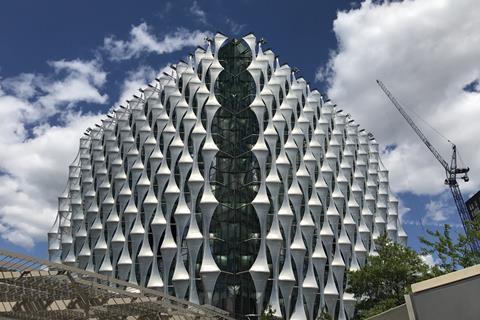
Ballymore decided to focus on four plots of land in particular: The Southbank Business Centre; a stationery building owned by Transport for London (TfL); a DHL warehouse; and a Jack Barclay car dealership. The four sites, which amounted to 21 acres, were acquired in less than six months between March and October 2007 for around £160m.
At the time, Ballymore knew that the US was eyeing up different options for its new embassy, but Mulryan says the company’s site acquisition spree was not driven by a desire to strike a deal with the US government.
“The main rationale around the acquisitions was their location, so close to the West End, on the river,” Mulryan says. “And from a simple yield perspective, it was really good value compared with other central locations in London.”

The idea to approach the US came “very shortly” after the land assembly had been completed, with Ballymore’s agent CBRE putting the location to Cushman & Wakefield. It was a bold move.
“You have to realise that at the time, Nine Elms was nothing,” says Mulryan. “Most people in London probably didn’t even know where that was.
”We managed to convince them that this was all going to change, that there was a lot of momentum building in that area and that it was the place of the future.”
Following this initial contact, a “long and careful” process began. Negotiations between Ballymore, the US Department of State, US Congress and Wandsworth Borough Council lasted almost nine months. Eventually, “little things” helped in convincing the US Nine Elms was the best option.
“The thing that really surprised them was its distance from the Houses of Parliament,” Mulryan reveals. “We literally showed them that you could walk from the new site to parliament quicker than from their location in Mayfair.”
Big site requirement
All of a sudden, the US began to look differently at the site. Another factor that helped to tip the balance in Ballymore’s favour was the simple fact that the US needed a vast site.
“They had requirements for five acres,” says Mulryan. “That’s the minimum that they needed to guarantee the highest standard of security for their facility. Five acres in the middle of London is not an easy thing to find.”
The US and Ballymore signed a conditional agreement in October 2008. Then the real work began. “Under the land deal, we still had to provide them with a fully serviced site,” Mulryan explains. “We had to do a huge amount of infrastructure work. It was a long process, which took the best part of two years.”
Works included diverting the local Ponton Road and building a new road access. Ballymore also had to remediate part of the site, which was contaminated from its former industrial use – the clean-up cost alone came in around £10m. More importantly, the developer had to obtain change of use for the site and get planning permission from the local authority.
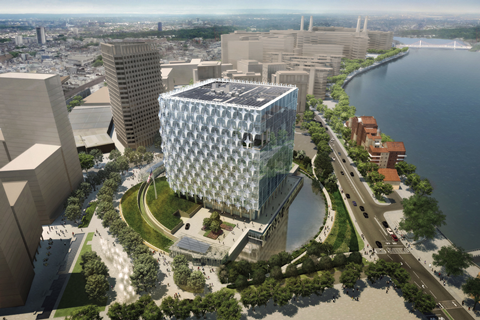
Luckily, Mulryan says, the council shared Ballymore’s vision. “Wandsworth is a very good council – very strong and progressive. They saw the opportunity too and really supported us,” he says.
The site was eventually cleared and in 2010 the deal completed. Mulryan refuses to comment on the specifics, but documents from the Land Registry obtained by Property Week show that the site was sold to the US for around £120m (around $200m at the time).
“We never talked about the deal,” says William Jackson, who at the time worked at Cushman & Wakefield and advised the US. “One of the conditions for it [the deal completing] was that there would be no press or publicity around it.”
“They had requirements for five acres, five acres in the middle of London is not an easy thing to find”
John Mulryan, managing director at Ballymore
In the meantime, the US put the leasehold on its embassy in Grosvenor Square up for sale and received a number of offers, including one from Grosvenor, which was interested in buying back the leasehold it had sold in the 1950s.
Eventually, in November 2009, the old embassy was sold to Qatari Diar, the real estate arm of Qatar’s national fund for an undisclosed sum. Land Registry records show the purchase price was £315m, which at the time was equivalent to more than $500m.
The US also agreed a $33m sale and leaseback of the Grosvenor Square site, which it would retain occupancy of until the new embassy was built. It eventually paid an additional $25m in rent because of delays to the project.
Construction at Nine Elms officially started in November 2013 and took more than four years to complete. According to OBO’s then director Lydia Muniz, the estimated cost for the construction was $775m. This figure, which excluded the land acquisition in Nine Elms and the leaseback of the old embassy, means that the new compound is the single most expensive embassy ever built by the US.
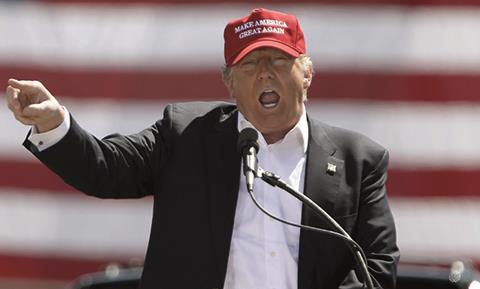
It is also the most ambitious. Designed by Philadelphia-based architecture firm KieranTimberlake, the 97-metre-tall, 12-storey, 518,000 sq ft building includes an outer shining armour on three of its facades – scrim made of a plastic material that contains photovoltaic cells – blast-proof glass windows, six gardens and a moat as well as a number of “special features” that remain strictly classified.
Such a gargantuan scheme was subjected to close government scrutiny. A declassified report shows that the US Department of State had concerns regarding the construction budget, but that the project was ultimately given the green light as it was “cost neutral”.
OBO, the report says, “planned a self-financing approach to fund the new embassy compound using proceeds from the sale of buildings owned by the department in London”.
These included the former embassy sold to Qatari Diar and the Navy Annex building, a nearby facility at 20 Grosvenor Square that was used by Dwight D Eisenhower as his European headquarters during the Second World War. The latter was sold in 2007 by the US to billionaire Richard Caring for £250m (around $450m at the time). The two sales alone brought in almost $1bn.
It is rumoured that the total cost of building the new embassy came in at around £1.023bn, but this hasn’t been officially confirmed by the US.
“We aren’t at liberty to comment on the specific details of contracts with private entities,” a state department official tells Property Week, confirming that “the new London embassy project was funded entirely from proceeds of sale of other US government property in the UK”.
The official adds: “Because the project was funded entirely from proceeds of sale, no tax dollars were used in executing the project.”
‘Waiting to happen’
In light of this evidence, does the new embassy represent a “bad deal”, as Trump claims? “You can debate whether it was a good or bad deal, but in a way it slightly misses the point,” believes Mulryan.
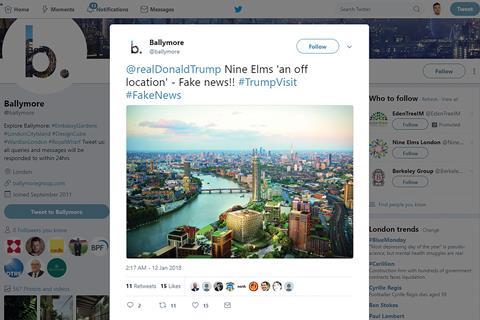
“Their decision to move here triggered one of the biggest regeneration projects in Europe. Now it seems so obvious; Nine Elms is so central. It was just waiting to happen. But back then nobody felt that way.
“Nobody saw it coming. Even two years after the deal was completed, there were still people who would say: ‘We don’t believe you; they’re not going to do it.’ But they did.”
Mulryan says that this got lost in the conversation that followed Trump’s comments. “From a commercial point of view, they also made the right move at the right time. I think they should be really proud of that and take credit,” he adds.
“Their decision to move here triggered one of the biggest regeneration projects in Europe. Now it seems so obvious; Nine Elms is so central. It was just waiting to happen. But back then nobody felt that way”
John Mulryan, managing director at Ballymore
Mulryan is not the only one who thinks so. The day after Trump’s tweet, US ambassador Johnson wrote a column in which he said that the old embassy “had to move”.
The new embassy “is not just bigger than the old one; it is better”, he wrote. “It is the most secure, hi-tech and environmentally friendly embassy that the United States has ever built.”
Regardless of what Trump believes, you can’t really argue with the facts.

























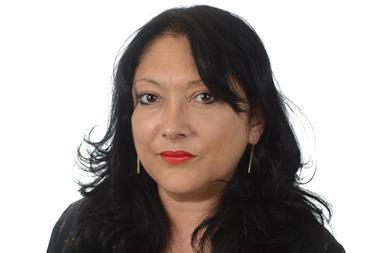



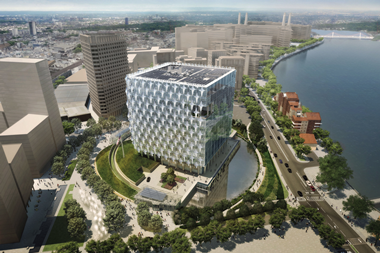

No comments yet